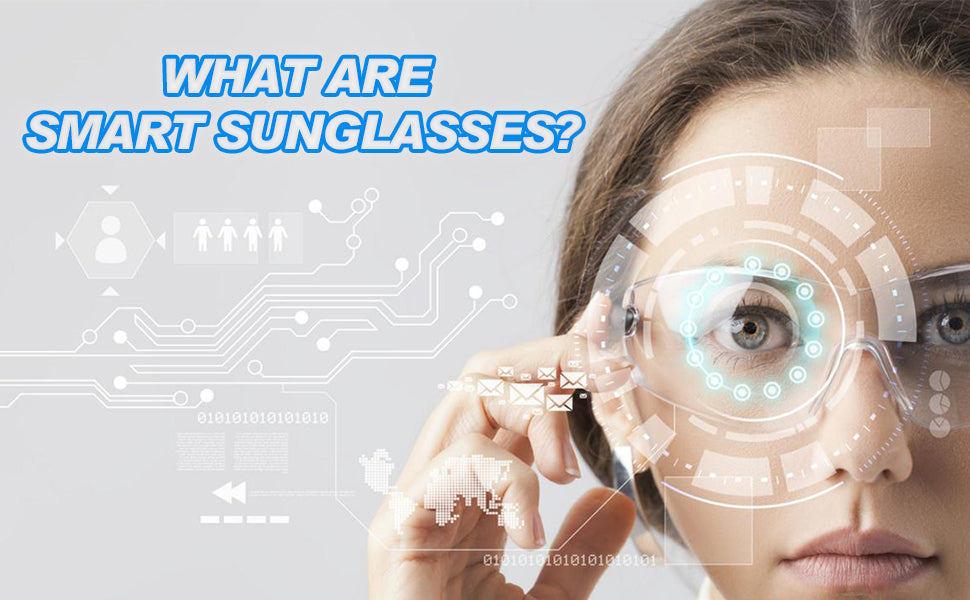
What Are Smart Sunglasses?
Need is the mother of all inventions. Technological innovations have always upgraded our lifestyles. It creates products that not only solved problems we face but also bring convenience, comfort, and progress to our lives. Smart Sunglasses are the latest addition to such innovations in eyewear.
In earlier days, the telephone, camera, music player, newspaper, and many more were all separate commodities that took distinct spaces in our houses while we enjoyed their benefits. And then cellphones arrived. Rest is history.
With the power of the internet as the bloodline, mobile devices facilitated the convenience, comfort, and the privilege of bringing all the utility services to your palm. You just need to bow down your head and browse through the mobile screens to explore the world and enjoy life.
What if you don’t even have to bow but just wear your sunglasses normally to enjoy music, read the newspaper, take pictures, and do much more? You can do all this while you get a clear vision ahead and remain protected from UV rays. Is that possible?
That’s exactly what smart sunglasses give you!
What Are Smart Sunglasses Used For?
Gone are the days when the usage of eyeglasses was limited to improving vision and protecting against harmful lights. If you have to wear your glasses and yet use mobile devices to conduct your work, then why not bring those device features to the eyewear itself?
Our eyeglasses are getting smarter, thanks to the evil collaboration between internet technology innovators and eyeglass manufacturers to take us to the next level of amazement. The stage is set; the world will dance in front of your eyes and you don’t even have to bow your head. Incredible isn’t it?!
The frames and lenses of our eyewear can now integrate the wireless connectivity and imaging we take for granted on our personal computers and cellphones. Our eyewear can provide us with the same versatility and interconnectivity; maybe much more in the coming years.
The beginning of the previous decade saw a rising demand for smartwatches and other wearable Bluetooth devices. Google was the pioneer in eyewear innovation in this category. In 2014, they introduced Google Glass Explorer. It was futuristic indeed, but unfortunately, the market envisioned it as an ahead-of-time product. It couldn’t relate to the benefits of such a wonderful device. Moreover, the design was not so comfortable, and that too at a whopping high price tag of $1,500.
Google had to discontinue this amazing eyewear but not before setting the trend for other manufacturers to pick up from there. Many global brands like X Glass, Microsoft HoloLens, Sony, Ray-Ban, Bose, and many more envisage the potential in this innovative eyewear and adopted the technology. They replicated the product with better designs and features, suiting the wearer’s comfort, needs, and budget.
With technology embedded in the frame, smart glasses provide your eyes a way to see images without interfering with your vision. Eyewear has become a platform for displays and sensors. No external devices or applications are needed.
Let’s dive into the many functionalities these technically advanced smart sunglasses provide.
Functionalities of Smart Sunglasses
Audio
The speaker for wireless audio and internet connectivity is placed at the rear end of the ear rest. Audio is delivered to the ear through the auditory canal via bone conduction instead of air conduction.
Microphone
One hinge embeds the microphone for hands-free voice searches and phone conversations. The newer models of smart glasses combine the microphone with a mini speaker for audio notifications and feedback. You can also listen to music and podcasts on the go.
Camera
Filming without permission was a major concern in Google Glasses. The camera lenses in smart glasses these days are small enough to fit discreetly into the frame of their devices. Some brands offer camera-less variants.
Projector
This projection technology, also known as Curved Mirror or Curved Mirror Combiner, is above the upper half of the lens and provides a balance between the digital displays and the real-world view. A variant known as waveguide holographic optics enables the digital overlay of text and images within our visual field. This perspective is the key to unlocking the smart glasses experience.

Control
Instead of using a keyboard and mouse, we can control smart glasses by touching, tapping, or swiping controls embedded into the frame, voicing our requests as we do with Alexa and Siri. Some smart glasses makers have advanced features like gesture detection of the head, eye, and hand movements such as nodding or looking up or down, directing via eye tracking, and even controlling our thoughts.
Better Vision Quality
Several variants use liquid crystal technology to allow wearers to filter the amount of light passing through their smart lenses. Controlling brightness is a technological advancement over photochromic or transitional lenses, and it has the potential to eliminate the need for sunglasses.
Smart Sunglasses for Commercial Use
As the consumer market for smart sunglasses is taking momentum for their fun and purpose, what is making the graph rise higher is its commercial application. These technologies promise to have the greatest impact on business and industrial applications. It has the potential to increase productivity and efficiency while reducing previously unavoidable risks.
It gives the workforce an entirely new perspective on how to look at data, complete tasks, assess performance, and achieve operational goals.

With Virtual Reality (VR) headsets, workers may learn new, complicated skills faster and at a lesser expense by simulating real-world tools and situations. Remote video collaboration is encouraging an increasing number of businesses to adopt this eyeglasses technology solution, from routine field service check-ups to intricate engineering support, telemedicine, and sophisticated procedures.
The instructions may be seen and overlaid on the smart glasses, doing away with the requirement for a printed operational manual. This would not only shorten the repair time but also minimize human error. Field service staff can access information about customer information, job sites, and real-time sensor data from equipment.
To translate written language and gather more information on signs, labels, and papers, one can use Augmented Reality (AR) glasses.
Soon, VR and AR will be able to achieve real telepresence, allowing participants to send high-fidelity avatars or AR holograms of themselves into another person's office or meeting space with their facial expressions and gestures intact.
Factors to Consider When Purchasing Smart Sunglasses
Vision Clarity
The main purpose of eyeglasses, vision correction, must still be carried out. Smart glasses users will need to monitor their visual health as they adjust to the extraordinary mixed images that lie ahead.
Driving Safety
Smart glasses wearers have a higher probability of getting distracted, which might make them and others in a precarious situation, especially while driving.
Privacy Violation
It may be socially unpleasant to assume that you are photographing or filming somebody without their knowledge or consent. Privacy violations in some countries are a serious crime.
Adaptability
The wearer needs to learn how to adjust to and react to the flow of wireless data, imaging, and audio from their now smart glasses, besides learning how to use the new tools that are physically there in front of their eyes.
Conclusion
Every innovation is met with objections and skepticism only to get better. Smart sunglasses have arrived and are here to stay. They’re already being used by millions of people around the world, and we expect their popularity to grow even further over the next couple of years. No wonder there is a rising demand for enhanced versions of new variants. It has broadened the avenues of vision solutions. You may probably like to own one, sooner than later.





